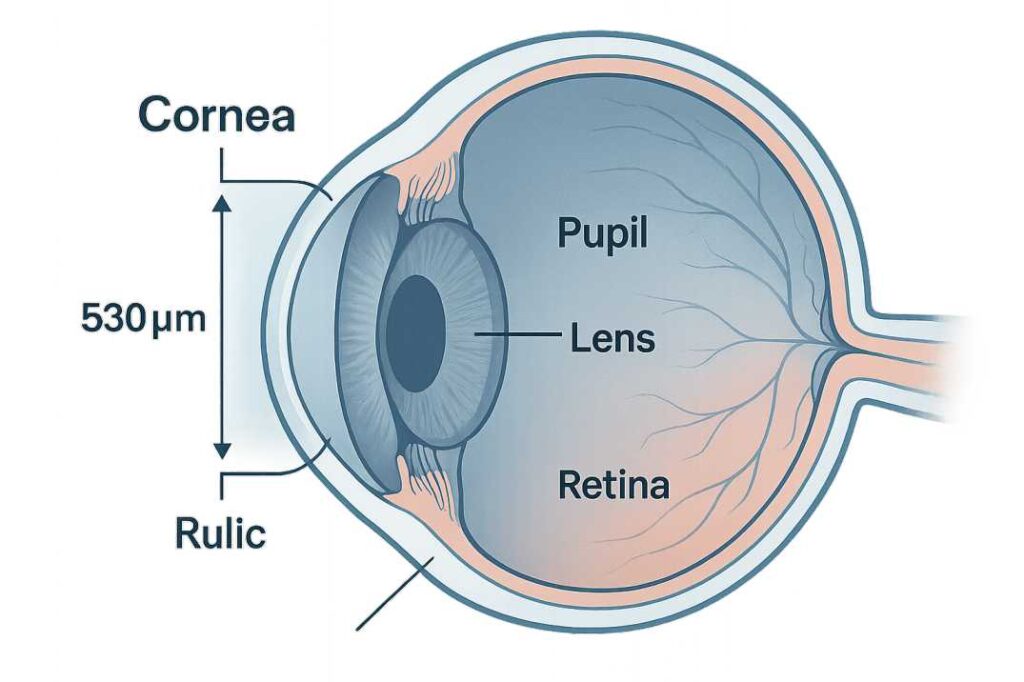LASIK Candidacy Evaluation: What to Expect & Who Qualifies
Considering LASIK eye surgery is an exciting step toward freedom from glasses and contact lenses. Whether you struggle to see clearly during your morning commute, find yourself frustrated by fogged-up lenses during Seattle’s rainy days, or simply want the convenience of waking up with clear vision, you’re not alone. Over 10 million Americans have undergone LASIK surgery since FDA approval, with approximately 700,000 to 800,000 procedures performed annually in the United States.
However, LASIK isn’t right for everyone. Understanding whether you’re a good candidate requires comprehensive LASIK evaluations that go far beyond a simple eye exam. This guide walks you through everything you need to know about LASIK evaluations, helping you make an informed decision about your vision correction journey.
Understanding LASIK Candidacy: What Makes Someone a Good Candidate?
The path to successful LASIK begins with understanding the basic eligibility requirements. Good candidates must be at least 18 years old, maintain stable vision prescriptions for at least one year, and be free from certain eye diseases and health conditions that could affect healing.
Age and Vision Stability
Your eyes continue changing through your teenage years and early twenties. Candidates should achieve ocular maturity with stable prescriptions before considering surgery. Most surgeons recommend waiting until your prescription hasn’t changed significantly for one to two years, ensuring the surgical correction remains effective long-term.
While there’s no strict upper age limit, older adults should know that LASIK doesn’t prevent age-related vision changes like presbyopia, which typically begins in the early to mid-40s. Many patients over 40 may still need reading glasses after surgery, even if their distance vision improves dramatically.
Prescription Range and Refractive Errors
LASIK effectively corrects three common vision problems. The procedure can generally treat nearsightedness up to -12 diopters, farsightedness up to +6 diopters, and astigmatism up to 6 diopters. However, these ranges can vary based on the specific technology used and individual eye characteristics. If your prescription falls outside these ranges, alternative procedures like PRK, SMILE, or implantable collagen lenses might be better options.
Overall Health Considerations
Your general health plays a crucial role in candidacy. Certain conditions, like uncontrolled diabetes or autoimmune diseases, must be well-managed before you can safely undergo LASIK. These conditions can affect your body’s healing response, potentially leading to complications.
Pregnancy and breastfeeding cause hormonal fluctuations that temporarily change your vision prescription. It’s essential to wait until after pregnancy and nursing to ensure your prescription has stabilized before proceeding with surgery.
The Comprehensive LASIK Evaluation Process
LASIK evaluations are comprehensive assessments that typically take one and a half to two hours and involve multiple specialized tests. Understanding what to expect during LASIK evaluations helps you prepare and ensures you get the most accurate assessment of your candidacy.
Pre-Evaluation Preparation
Before your evaluation, you’ll need to stop wearing contact lenses for a specific period. Soft contact lens wearers typically need to discontinue use for one to two weeks, while rigid gas permeable lens wearers may need to wait longer. Contacts temporarily reshape your cornea, and this can lead to inaccurate measurements during LASIK evaluations if worn too close to your appointment.
Bring a complete list of current medications, including over-the-counter supplements. Some medications can affect healing or disqualify you from surgery. Be prepared to discuss your medical history, vision goals, and daily visual needs with your eye care team.
Essential Diagnostic Tests
Corneal Thickness Measurement (Pachymetry)
Corneal thickness is one of the most critical factors in LASIK candidacy. LASIK thins the cornea during the reshaping process, so adequate corneal thickness is vital to maintain structural integrity after surgery. Surgeons measure thickness using ultrasound or optical methods to ensure you have enough tissue for safe correction.
Most candidates need a corneal thickness of at least 500 microns to safely undergo LASIK, though many healthy eyes have corneas around 550 microns thick. Thinner corneas increase the risk of complications like corneal ectasia, where the cornea bulges outward after surgery.
Corneal Topography and Tomography
Corneal topography creates a detailed map of your cornea’s surface, analyzing its shape and identifying any irregularities that might affect surgical outcomes. Advanced imaging, like the Pentacam system, provides three-dimensional views, offering even more detailed information about corneal structure.
These sophisticated mapping techniques help your surgeon customize the laser treatment to your unique eye anatomy, improving both safety and visual outcomes.
Tear Film Evaluation
Dry eye syndrome is the most common side effect after LASIK. Studies report that anywhere from 4% to 60-70% of patients experience varying degrees of dryness after LASIK, though symptoms usually resolve within three to six months.
Your evaluation includes tests to measure tear production and quality. If dry eye syndrome is diagnosed during the pre-operative evaluation, it should be appropriately managed before proceeding with surgery. Untreated dry eye before surgery significantly increases the risk of chronic dryness afterward.
Pupil Size and Dilation
Large pupils can increase the risk of night vision problems like halos and starbursts around lights. During your evaluation, your pupils will be dilated to examine the internal structures of your eyes and rule out conditions like glaucoma or retinal problems.
Plan to have someone drive you home after the evaluation, as dilation can cause temporary blurriness and light sensitivity lasting several hours.
Refraction Testing
This determines your exact eyeglass prescription and the degree of your refractive error. Your eye doctor uses a phoropter—the device where you choose between “one or two”—to systematically measure how light changes as it enters your eyes.
Conditions That May Affect LASIK Candidacy
Several eye conditions and systemic diseases can impact whether LASIK is safe for you. Understanding these factors helps set realistic expectations for your consultation.
Eye-Specific Conditions
Certain eye diseases, including keratoconus, severe cataracts, severe cases of amblyopia, active infections, and certain retinal and optic nerve diseases, may render you a non-candidate for LASIK. These conditions either affect the structural integrity of your eye or interfere with the healing process.
Glaucoma, corneal scarring, and a history of herpes eye infections also require careful evaluation. In many cases, alternative vision correction procedures may still be available.
Systemic Health Factors
Autoimmune diseases like lupus or rheumatoid arthritis, certain medications including corticosteroids and acne medications, and pregnancy can all affect the healing process after LASIK. Being forthright about your complete medical history ensures your surgeon can make the safest recommendation.
Understanding LASIK Safety and Success Rates
Recent clinical research provides reassuring data about LASIK safety and effectiveness, helping you make an evidence-based decision.
Current Success Rates
Recent studies show that over 90% of LASIK patients achieve 20/20 vision or better, with patient satisfaction rates ranging from 96% to 99%. These remarkable outcomes place LASIK among the most successful elective procedures performed today.
A comprehensive 18-year audit of over 53,000 eyes found that 95.43% of eyes had no loss of vision postoperatively, with serious complication rates remaining well below 1%. The average cost of LASIK in 2025 ranges from $1,500 to $3,000 per eye, or approximately $2,200 to $2,500 per eye on average, depending on the technology used and geographic location.
Long-Term Outcomes
A 2024 meta-analysis reviewing 26 high-quality studies involving 1,879 LASIK patients found stable visual outcomes with minimal complications for patients with myopia and astigmatism. Long-term studies demonstrate that LASIK corrections remain largely stable over decades, with only minor changes in certain higher prescription groups.
Recent Scientific Evidence Supporting LASIK Safety
-
Long-term Clinical Outcomes of LASIK Surgery (2024) – This systematic review and meta-analysis, published in the Journal of Advanced Trends in Medical Research, examined data from 1,879 LASIK patients across 26 high-quality studies. The research confirmed statistically significant improvement in uncorrected visual acuity for myopic patients with minimal complications, demonstrating LASIK’s effectiveness for long-term vision correction. Read the study
-
LASIK Outcomes and Complications: 2016 to 2023 (PubMed, 2025) – This comprehensive analysis reported that 92.6% of patients are satisfied with their LASIK results, and 99% would recommend the surgery to others. The study reviewed outcomes across years, tracking the evolution of techniques and technology that have further improved safety profiles and patient satisfaction.
-
Eighteen-Year Prospective Audit of LASIK Outcomes (2018, Updated Data) – One of the longest-running clinical audits examined 53,731 eyes of 27,312 patients who underwent myopic LASIK between 1998 and 2015. The study found that more than 99% of eyes achieved vision of 20/40 or better, with 70% achieving 20/20 vision, while the overall complication rate remained below 1%. This extensive real-world data demonstrates consistent safety and efficacy across nearly two decades.
The Dry Eye Consideration
Dry eye deserves special attention when considering LASIK, as it’s both a risk factor before surgery and a potential side effect afterward. Studies report that dry eye symptoms can affect a significant number of patients after LASIK, though the exact percentages vary widely across different studies, ranging from around 4% to as high as 60-70% depending on how symptoms are measured and defined.
How LASIK Affects Tear Production
LASIK temporarily disrupts corneal nerves that regulate tear production by creating a flap in the cornea. While these nerves typically regenerate within six to twelve months, incomplete regeneration can lead to reduced tear production and chronic dryness in some patients.
Virtually all patients develop some degree of dryness in the immediate postoperative period, but for most, symptoms resolve within the first three to six months. Patients with pre-existing dry eye before surgery face higher risks of persistent symptoms.
Managing Dry Eye Risks
If you have dry eye symptoms before LASIK, requesting a detailed evaluation and treating underlying conditions before surgery can minimize the chance of developing chronic dry eyes afterward. Treatment options include artificial tears, prescription medications like cyclosporine or lifitegrast, and, in some cases, punctal plugs to reduce tear drainage.
For patients with moderate to severe dry eye, alternative procedures like PRK may be recommended, as they don’t involve creating a corneal flap and typically result in fewer long-term dry eye complications.
Alternative Vision Correction Options
Not everyone who wants laser vision correction is a good LASIK candidate. Fortunately, several alternatives exist.
Photorefractive Keratectomy (PRK)
PRK removes the very thin top layer of the cornea rather than creating a flap, then reshapes the cornea with a laser. While recovery takes longer than LASIK—typically several days to weeks—PRK may be better for patients with thin corneas or those in professions with a high risk of eye trauma.
Small Incision Lenticule Extraction (SMILE)
SMILE uses a laser to create a thin disc in the cornea, which is removed through a small incision without creating a traditional flap. This procedure may reduce dry eye symptoms and is particularly suitable for patients with nearsightedness and astigmatism.
Implantable Collamer Lenses (ICL)
For patients with very high prescriptions or thin corneas who aren’t candidates for laser procedures, implantable lenses placed inside the eye can provide excellent vision correction. These lenses are reversible and don’t permanently alter corneal structure.
Additional Resources and References
For readers seeking more detailed information about LASIK evaluations and candidacy, the following authoritative resources provide comprehensive guidance:
-
Mayo Clinic – LASIK Surgery: Is it Right for You?
https://www.mayoclinic.org/tests-procedures/lasik-eye-surgery/in-depth/lasik-surgery/art-20045751
This comprehensive Mayo Clinic guide covers candidacy factors, evaluation requirements, procedural details, and potential complications. Updated May 2025, it provides evidence-based information on what makes someone a good LASIK candidate and what to consider when making your decision. -
American Refractive Surgery Council – LASIK Candidate Guidelines
https://americanrefractivesurgerycouncil.org/general-lasik-candidate-guidelines/
The Refractive Surgery Council provides detailed guidelines on the five key factors surgeons use to determine LASIK candidacy, including prescription ranges, eye health requirements, and systemic health considerations. This resource explains why 15-20% of prospective patients don’t qualify for LASIK. -
FDA – LASIK Information and Resources
https://www.fda.gov/medical-devices/lasik
The U.S. Food and Drug Administration’s official LASIK resource center offers information on safety, FDA-approved devices, patient screening criteria, and the PROWL (Patient-Reported Outcomes With LASIK) studies that track long-term patient satisfaction and outcomes.
Making Your Decision: Essential Questions for Your LASIK Evaluation
Coming prepared with the right questions ensures you get the information needed to make a confident decision:
- Am I a good candidate for LASIK, or would an alternative procedure better suit my specific situation?
- What is my specific risk profile for complications based on my corneal thickness, prescription, and overall health?
- How many LASIK procedures has the surgeon performed, and what are their complication rates?
- What technology and techniques will be used for my procedure?
- What should I realistically expect for my visual outcome based on my prescription and eye anatomy?
- How will my dry eye symptoms (if present) be managed before and after surgery?
- What is the enhancement rate, and is retreatment included if needed?
- What are the total costs, and does my vision insurance provide any coverage?
Understanding the LASIK Evaluation Results
After completing all diagnostic tests, your surgeon will review the results with you in detail. Ideal candidates typically demonstrate stable prescriptions, adequate corneal thickness, healthy tear film, and no contraindicated eye conditions or systemic diseases.
If you’re a good candidate, you’ll receive a personalized treatment plan explaining the procedure, expected outcomes, recovery timeline, and associated costs. If LASIK isn’t recommended, your surgeon should explain the specific reasons and discuss alternative options that might better suit your needs.
Remember that between 15 and 20 percent of patients are considered ineligible for LASIK. This screening process exists to protect your vision and ensure the best possible outcomes for those who do proceed with surgery.
The Cannon EyeCare Difference: Comprehensive LASIK Evaluations with Personalized Care
At Cannon EyeCare, we understand that choosing LASIK is a significant decision that deserves careful consideration. Our comprehensive LASIK evaluations combine state-of-the-art diagnostic technology with the unhurried, personalized attention that reflects our Midwestern values. Located conveniently in University Village and Pike Place Market, we’re committed to providing Seattle professionals with expert eye care that goes beyond basic examinations to identify issues others might miss.
While we don’t perform LASIK surgery in-house, our thorough LASIK evaluations ensure you have all the information needed to make the best decision for your vision and lifestyle. If LASIK is right for you, we collaborate with trusted surgical partners to ensure you receive exceptional care throughout your journey. If alternative treatments better suit your needs—whether specialty contact lenses, comprehensive dry eye management, or other vision solutions—we’re here to provide ongoing support and expert guidance.
Taking the Next Step
Determining whether you’re a good LASIK candidate starts with comprehensive LASIK evaluations. The investment of time in a thorough assessment ensures any vision correction procedure you choose is both safe and effective for your unique eyes.
Whether you’re a busy professional tired of glasses fogging up during Seattle’s drizzly weather, an active individual wanting freedom for sports and outdoor activities, or someone simply seeking the convenience of clear vision 24/7, understanding your candidacy through proper LASIK evaluations is the first step toward achieving your vision goals.
Schedule a comprehensive eye examination to discuss your vision correction options. Your eye care team will evaluate your candidacy, answer your questions, and help you make an informed decision about the best path forward for your vision needs.
This article is for educational purposes only and does not replace professional medical advice. Schedule a comprehensive eye examination with a qualified eye care provider to discuss your specific vision correction needs and determine your LASIK candidacy.
FAQs
-
You must be at least 18 years old for LASIK candidacy evaluation, though most surgeons prefer candidates over 21 when vision typically stabilizes.




